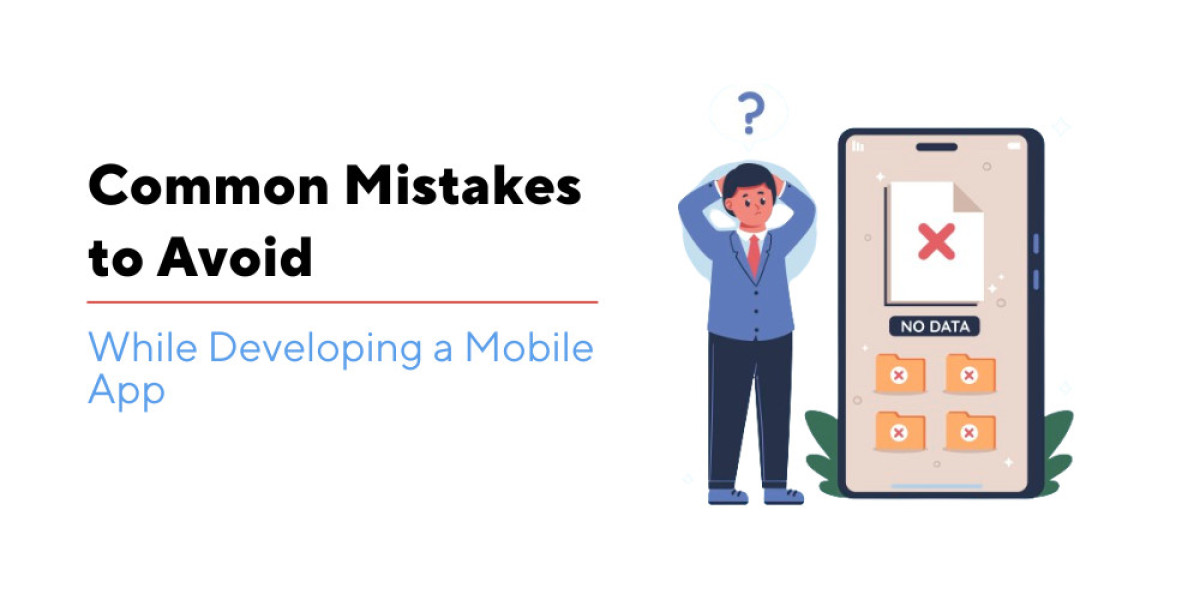In today’s dynamic world of rapid mobile app development, avoiding common pitfalls and staying updated with the best practices help top mobile app development companies develop top-notch mobile apps with the best functionalities that meet specific business and project needs.
Derailed projects due to minuscule issues such as improper development of the user experience (UX) and inadequate development of the technical aspects decrease an app's quality and usability. As a developer or a custom mobile app development company, considering potential factors to ensure the application runs and operates as designed is dependent on the major processes and the essentials of the Software Development Lifecycle (SDLC).
Application faults lead to reduced mobile app engagement, giving rise to frequent uninstallations and faltering business journeys. That’s when the instrumental role of a custom mobile app development company comes into play.
This blog will discover the common and petty mistakes developers commit during the development cycle that reduce the app quality and customer satisfaction with digital products.
Mistakes to Avoid While Developing a Mobile App
Developing a mobile app presents a million opportunities to innovate and engage users. That’s why out-house mobile app development services are the cornerstone to meet all, and comprehensive needs of an efficient mobile application. However, it's crucial to navigate carefully and prevent the most critical mistakes while developing a mobile app, empowering you to create a compelling and user-centric digital product.
Let’s delve quickly.
Ignoring user research and testing
Invest resources in evaluating the target audience through surveys, interviews, and usability testing. The ultimate goal for a mobile app is to satisfy the end-users and meet the expectations of businesses. This data can impact your design decisions and iterate based on user feedback. Skipping user research and testing creates apps that don't meet user expectations.
Overloading features
Loading an application's interface with features that are least required and confuse users will lead to more uninstallation of applications. Many studies have reflected that either the lack of necessary app features or the load of unnecessary features is primarily the cause of frequent discarding of mobile apps by users. Maintaining an iterative approach to gradually introduce meaningful features based on user feedback is the key to developing a mobile app that resonates the most closely with users.
Neglecting platform guidelines
Adhering to the platform-specific design guidelines is a vital practice for a custom mobile app development company to ensure the user's device is compatible with the application's configurations. To gain more trust and cultivate more familiarity with the application, mobile app development companies must consider their app's design and its alignment.
Poor onboarding experience
Complicated and deterring onboarding phases before setting up the application can be an annoying experience for a user, which eventually leads to the discarding of the app in the earliest phase. A custom mobile app development company should work to keep this phase concise and entertaining to create an exciting and engaging experience while installing an app.
Ignoring performance optimization
Neglecting performance optimization is a major cause of poor user experience and inadequacy in the application’s functions. Increased loading and response time, unoptimized code, and database, and poor server performance are several factors that reduce the application’s performance efficiency. Browser caching, compressed images, Content Network Delivery (CDN), and minification are strategies to overcome optimization conflicts.
Lack of personalization
Personalizing applications is a tested strategy to attract more users and increase the client base. Implementing measures like behavioral targeting, geolocation targeting, contextual messaging, adaptive UI/UX, personalized recommendations, customization, and user preferences are effective in personalizing the mobile app.
Inadequate security measures
Overlooking security measures can expose user data to vulnerabilities, risking user trust and compliance with data protection regulations. Incorporate robust security measures, such as data encryption, secure authentication, and regular security audits, to protect user data and ensure a secure app environment. When it comes to integrating robust security measures, offshore development center helps massively, fulfilling all the business needs.
Ignoring accessibility
Sidelining users with differential needs can affect the number of users your mobile app draws. Implementing accessibility guidelines and WCAG compliance are important to make the mobile app inclusive and universally accessible. Assistive technologies, screen reader support, effective color usage, avoiding flickering lights or moving vector elements, and text-to-speech integration are proven strategies to increase the likability and accessibility of a mobile application.
Not prioritizing feedback and updates
Collecting and analyzing user feedback is essential to improve and enhance mobile applications. Adhering to the Agile best practices and promoting iterative and continuous development enhance update management and version control.
Disregarding cross-platform compatibility
Agnostic is the current term to ensure a mobile app is operational on various platforms. Developing apps that are operating system and device-agnostic is the key to creating apps that operate on multiple platforms. Cross-platform development is an essential part of today’s world surrounded with gazillions of mobile apps and devices with specific configurations. Measures to tackle this is to conduct compatibility testing, creating responsive designs, integrating APIs, developing scalable architecture, and maintaining UI/UX consistency.
Technical Factors that Contribute to the Development of an Inadequately Performing Mobile App
Insufficient caching mechanisms
Poor database optimization
Over-reliance on synchronous API calls
Inefficient memory management
Lack of code modularization
Failure to leverage background processing effectively
Excessive network requests
Incompatible libraries or dependencies
Inadequate error handling and logging
Ignoring device-specific performance considerations
Top Tools to Resolve Common Mistakes while Mobile App Development
The tools listed below are essential in ensuring the development of a user-friendly app with minimum to no complexities. Moreover, these tools steramline the tasks, cutting down the manual effort, operational costs, and time of developers.
User Research and Testing
User research and testing are crucial in app development as they provide valuable insights into user preferences, behaviors, and pain points. This helps tailor the app's design and features that effectively meet user needs.
Top tools:
UsabilityHub
UserTesting
Optimal Workshop
Hotjar
Lookback
Feature Overload Management
Feature Overload Management refers to the practice of carefully selecting and implementing features that provide a meaningful, streamlined, and seamless experience to users without overwhelming them.
Top tools:
Pendo
Mixpanel
Amplitude
Appsee
Heap
Platform Guidelines Adherence
Adhering to platform guidelines ensures consistency and familiarity for users, leading to a better user experience and increased trust in your app's quality and reliability. It also helps your app blend seamlessly with the native environment, improving usability and reducing friction for users.
Top tools:
iOS Human Interface Guidelines
Material Design Guidelines
Android App Quality Guidelines
Windows App Certification Kit
Apple Design Resources
Onboarding Experience Design
Designing a smooth onboarding experience introduces users to your app's value, simplifies initial setup, reduces abandonment rates, and boosts user engagement from the start. It sets the tone for a positive user journey and increases the likelihood of users exploring and adopting key app features.
Top tools:
Appcues
Userpilot
WalkMe
Pendo
Intro.js
Performance Optimization
Performance optimization involves enhancing app speed and responsiveness, ensuring a smooth user experience. Tools like New Relic and Google PageSpeed Insights provide insights and suggestions to improve app performance metrics effectively.
Top tools:
New Relic
Google PageSpeed Insights
YSlow
GTmetrix
WebPageTest
Personalization Features
Personalization tailors a unique and user-centric app navigation experience, giving preference to specific and individual preferences. This fosters an interactive and highly engaging user experience to users, producing higher satisfaction.
Top tools:
Segment
Amplitude
Optimizely
Mixpanel
Google Analytics for Firebase
Security Measures Implementation
Implementing security measures ensures user trust and data protection, protecting sensitive information and maintaining data integrity at all costs.
Top tools:
Auth0
AWS Identity and Access Management (IAM)
Okta
Azure Active Directory
Duo Security
Accessibility Design Considerations
Accessibility designs ensure the app is inclusive and accessible to all users worldwide, especially to those with specific and discrete needs. Moreover, it ensures the
Mobiel app complies with regulatory requirements for a standard application.
Top tools:
Axe Accessibility Testing
Wave Accessibility Evaluation Tool
Color Contrast Analyzer
JAWS Screen Reader
NVDA (NonVisual Desktop Access)
Feedback Collection and Updates Management
Maintaining feedback collection and regular analyses improves the quality of mobile applications. Also, update management ensures upgraded version and a seamless experience to users.
Top tools:
UserVoice
Zendesk
Intercom
SurveyMonkey
Google Forms
Cross-Platform Compatibility Testing
Cross-platform compatibility testing guarantees increased user accessibility by allowing mobile apps to run across various devices and operation systems. Furthermore, cross-platform mobile apps gain more popularity among customers.
Top tools:
Appium
Xamarin Test Cloud
TestComplete
BrowserStack
Sauce Labs
Conclusion
In conclusion, mastering mobile app design and development requires a keen awareness of common mistakes and proactive strategies to avoid them. By prioritizing user research, adhering to design guidelines, optimizing performance, ensuring security and accessibility, and maintaining a feedback-driven iterative process, you can create mobile apps that stand out in today's competitive landscape. Avoiding these common mistakes is not just about delivering a functional app but also about crafting a delightful and engaging user experience that keeps users coming back for more.








